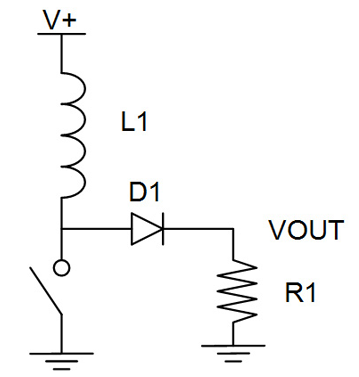Plasma arc lighter
Flyback transformer
But first the inductor...
To see the full material list of this project click here before you start the tutorial. To understand how the flyback stores energy and how it works first let's see how an inductor works. In order to increase our voltage we will take use of the inductor properties. Unlike a capacitor that tried as hard as it can to keep the voltage across it as stable as possible by sourcing and sinking surges of current, the inductor tries to keep its current stable as much as it can, by surging the voltage across it. So if you charge it to a certain current, it tries to not allow or slowly change the current.

What does that do for us? Let’s take a look at the circuit above. At the beginning the current through the inductor L1 is zero. When we close the switch, the inductor slowly allows the current to rise through. Say it rises to 1A and then we open the switch. But the inductor wants to continue driving 1A of current. So what will happen is that it will push the current through D1, which was off up to this point and turns it on, and the current runs through R1 resistor. Now let’s say R1 is 1kOhm. So 1A of current multiplied by 1k ohm is 1000V. That should be the generated voltage across the resistor in form of a spike that dissipates quickly. So just that easily, we created 1kV spike. This means that the voltage across the inductor on the diode side jumped close to 1000V, all in order to continue outputting 1A. In this tutorial we should be aware that if you generate huge voltages, all our components such as the inductor, switch, diode and resistor should be able to handle and not break under such voltages.
Flyback transformer
The thing is that we won’t use an inductor. But we had to take this small lesson about inductors in order to understand how the flyback converter works. A flyback transformer, also called a line output transformer, is a special type of electrical transformer. It was initially designed to generate high voltage sawtooth signals at a relatively high frequency. It is equivalent to that of a buck-boost converter with the inductor split in two to form a transformer. So this flyback transformer is like a normal one but the first coil is split in two coils. Unlike a normal transformer which operates at 50 / 60Hz, a flyback transformer is designed to operate at high frequency, so we cannot simply connect the primary coil of the flyback to a normal power supply. Instead, we need a circuit to generate a high frequency as input to the primary coil. This is the circuit that we are going to use and it is very beautiful in its simplicity. It cannot be run at very high power, and the transistor tends to get quite hot (and needs to be heat-sinked properly). Still, it is a very simple circuit for making high voltage, and can be used to draw electrical arcs.
Next page:

 About me
About me  History
History  Let's learn
Let's learn  Contact us
Contact us  Arduino tutorials
Arduino tutorials Circuits tutorials
Circuits tutorials  Robotics tutorials
Robotics tutorials Q&A
Q&A Blog
Blog  Arduino
Arduino  Circuits
Circuits Robotics
Robotics  Modules
Modules  Gadgets
Gadgets  Printers
Printers  Materials
Materials  3D objects
3D objects  3D edit
3D edit  Donate
Donate  Reviews
Reviews  Advertising
Advertising



